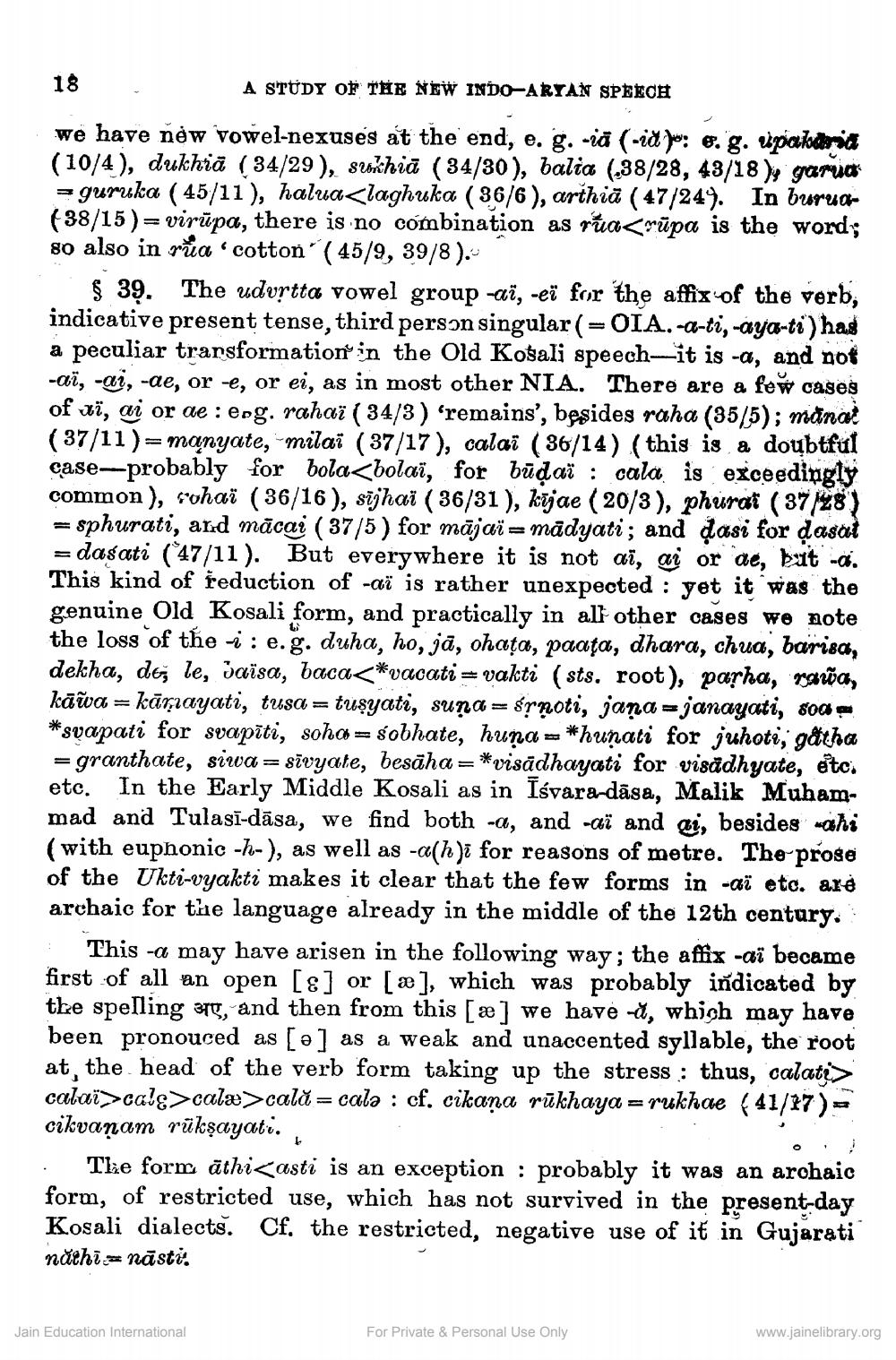________________
18
A STUDY OF THE NEW INDO-ARYAN SPEECH
we have nėw vowel-nexuses at the end, e. g. -lä (-id fo: e. g. upandeid (10/4), dukhiä ( 34/29), sukhia (34/30), balia (38/28, 43/18 )y garua = guruka ( 45/11), halua<laghuka (36/6), arthia ( 47/249. In burud(38/15 )= virūpa, there is no combination as rúa< mūpa is the word; BỘ also in rằia • cotton ( 45/9, 39/8 ).
$ 39. The udvrtta vowel group -aï, -eï for the affix of the verb, indicative present tense, third person singular(=OIA.-a-ti, -ayati) has a peculiar transformation in the Old Košali speech-it is -a, and not -aï, -ai, -ae, or -e, or ei, as in most other NIA. There are a few cases of vi, ai or ae : eog. rahaï ( 34/3) 'remains', besides raha (35/5); manat (37/11 )= manyate, milai (37/17), calai (36/14) (this is a doubtful case-probably for bola<bolas, for būdai : cala is exceedingly common), cohaï (36/16), sījhaï ( 36/31 ), kījae (20/3), phurat (37148) = sphurati, and mācai ( 37/5 ) for mājai = madyati; and dasi for dasat =dasati (147/11). But everywhere it is not ai, ai or de, baut -a. This kind of reduction of -aï is rather unexpected : yet it was the genuine Old Kosali form, and practically in all other cases we note the loss of the i : e.g. duha, ho, jā, chata, paata, dhara, chua, barisa, dekha, de le, vaïsa, baca<*vacati = vakti (sts. root), parha, rawa, kāwa = kāņayati, tusa = tuşyati, suņa = srņoti, jana = janayati, sode *svapati for svapiti, soha = sobhate, huna - *hunati for juhoti; gåtha = granthate, siwa= sīvyate, besäha=*visādhayati for visadhyate, etc. etc. In the Early Middle Kosali as in Isvara-dāsa, Malik Muhammad and Tulasi-dāsa, we find both -a, and -aï and ai, besides hi (with euphonic -h- ), as well as -a(h)i for reasons of metre. The prose of the Ukti-vyakti makes it clear that the few forms in -aï etc. are archaic for the language already in the middle of the 12th century. : This -a may have arisen in the following way; the affix -aï became first of all an open [&] or [æ], which was probably indicated by the spelling 3rg, and then from this [æ] we have d, which may have been pronouced as [ ] as a weak and unaccented syllable, the root at the head of the verb form taking up the stress : thus, calate> calai>calc>calæ>cală = cala : cf. cikana rūkhaya = rukhae (41/27 ) = cikvaņam rükşayati. • The form, äthi<asti is an exception : probably it was an archaic form, of restricted use, which has not survived in the present-day Kosali dialects. Cf. the restricted, negative use of it in Gujarati năthi = nāsti.
Jain Education International
For Private & Personal Use Only
www.jainelibrary.org




